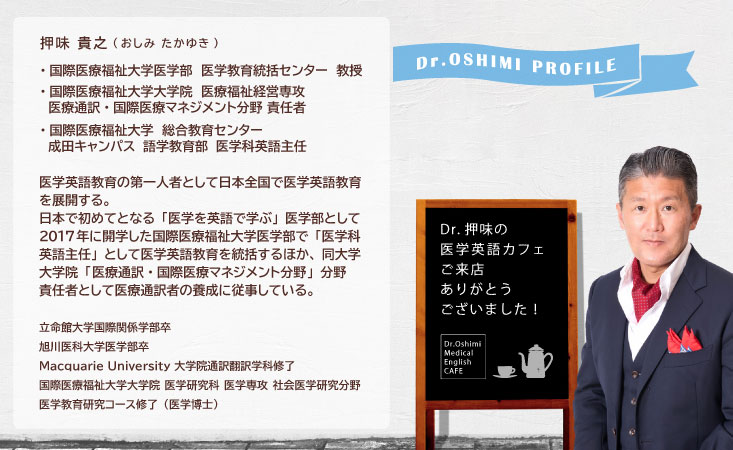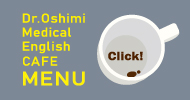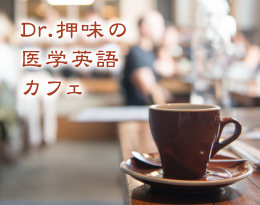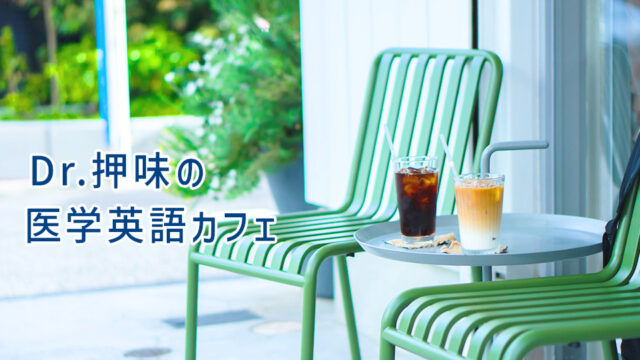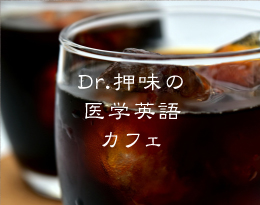
こんにちは。「医学英語カフェ」にようこそ!
ここは「コーヒー1杯分」の時間で、医学英語にまつわる話を気軽に楽しんでいただくコーナーです。
本日のテーマは「脳神経に関する英語表現」。
医学生にとって「脳神経」は解剖学や脳神経内科だけでなく、OSCEでも非常に重要な項目です。その名称を英語でも学んでいる方は多いと思いますが、その機能を調べるための身体診察や所見に関する英語表現となると意外と知らないという方も多いと思います。
そこで今月は脳神経に関する様々な英語表現をご紹介します。
そもそも脳神経って何でそんなに重要なの?
皆さんご存知の通り、「中枢神経系」 central nervous system (CNS) は「脳」 brain と「脊髄」spinal cord から成り立ち、それ以外の神経は「末梢神経系」peripheral nervous system (PNS) となります。この PNS は通常 spinal cord から出ていますが、「脳神経」cranial nerves (CN) は「脳」と「脳幹」から出ています。
神経系の症状がある場合、障害部位を特定するために様々な「神経学的診察」 neurological examination をします。
「脳」brain に障害があると考えるならば mini-mental state examination (MMSE) を行って認知機能や記憶の異常を探りますし、「大脳基底核」 basal ganglia や「小脳」cerebellum に障害があると考えるならば coordination の異常を探ります。同じように spinal cord に障害があると考えるならば deep tendon reflexes (DTR) を確認します。そして peripheral nerves に障害があると考えるならば sensation を確認し、neuromuscular junction (NMJ) や muscles に障害があると考えるならば motor function を確認します。
「脳神経」cranial nerves (CN) のうち、CN I は brain から、CN II は「間脳」diencephalon から出ていますが、CN III からCN VI の4つは「中脳」midbrain、そしてそれ以外の4つは「延髄」medulla oblongata からと、全て「脳幹」から出ています。つまり「脳幹」brainstem に障害があると考えるならば、cranial nerves の身体診察をすれば良いのです。その意味でも cranial nerves の身体診察は neurological examination において重要なものとなるのです。
Anosmia って何?
ではこの12対の脳神経に関する英語表現を具体的にみていきましょう。
CN I: Olfactory Nerve
Sensory: Smell
最初の脳神経は「嗅神経」olfactory nerve です。身体診察では省略されることが多く、口頭で “Have you noticed any changes in your taste or smell at all?” のように質問だけで済ませることが一般的です。
COVID-19 の症状としても重要な「嗅覚異常」dysosmia ですが、これには下記のような細かい表現もありますので、これを機会に覚えておきましょう。
Anosmia: 嗅覚消失
Hyposmia: 嗅覚鈍麻
Parosmia: 嗅覚錯誤
CN II: Optic Nerve
Sensory: Vision
2番目の脳神経が「視神経」optic nerve です。名称として「三叉神経」trigeminal nerve の1番目の枝に当たる「眼神経」ophthalmic nerve と混合される方がいるので気をつけましょう。
この optic nerve の診察では「視力検査」visual acuity test が重要となります。この visual acuity test に関する英語表現に関してはこちらの「気をつけたい視力検査での英語表現」にまとめておきましたので是非ご確認ください。
「色覚」color vision を検査する際には「石原式色覚検査表」を使いますが、これは英語では単純に Ishihara chart や Ishihara plates と呼ばれています。
Accommodation と Convergence って何?
次に「眼球運動」に関する3つの脳神経をみていきましょう。
CN III: Oculomotor Nerve
Motor: Eyeball/Pupil/Eyelid Movements
CN IV: Trochlear Nerve
Motor: Eyeball (Downward and Outward) Movements
CN VI: Abducens Nerve
Motor: Eyeball (Outward) Movements
3番目の脳神経が「動眼神経」oculomotor nerve です。これは眼球を様々な方向に動かすだけでなく、optic nerve と協調して「瞳孔反射」pupillary reflex にも関与しています。
この pupillary reflex は「ペンライト」pen light(英国では pen torch と呼びます)を使って「縮瞳」miosis を生じさせるため、「対光反射」light reflex とも呼ばれます。ここでは同じ眼に2回ずつ光を当て、同じ眼の「直接対光反射」direct light reflex と反対側の眼の「共感性対光反射」consensual light reflex を確認します。
こういったlight reflex の英語表現は明快なのですが、わかりにくいのが「調整反射」accommodation reflex での表現です。これは患者さんに「寄り目」をしてもらう検査で、両目が中央に寄る「輻輳(ふくそう)」convergence と、瞳孔の「収縮」constriction という2つの反応を見る検査です。
そして瞳孔の視診とこの light reflex および accommodation reflex の正常所見を表す表現が、 “The pupils are equal and round, react to light and accommodation.” で、この略語である PERRLA(「パーラ」のように発音) は英語圏の Patient Notes「カルテ」でもよく使われます。
ちなみに「縮瞳」は医学英語で miosis(「マィオゥシィス」のように発音)となり、「散瞳」は mydriasis(「ミィドラィアシィス」のように発音)となります。「ホルネル症候群」Horner syndrome では「縮瞳」の他に「眼瞼下垂」ptosis(「トォシィス」のように発音)と「無汗症」anhidrosis(「アンヒドロォシィス」のように発音)という症状が現れるのですが、英語ではこれらは ptosis, miosis, and anhidrosis のように「韻を踏む」rhyming ことで、日本語よりもはるかに覚えやすくなっています。
Oculomotor Nerve に加え、4番目の「滑車神経」trochlear nerve と6番目の「外転神経」abducens nerve を同時に調べる「眼球運動」 eye movements の検査では、「顔を動かさないで眼だけで指を追ってください。」 “Please follow my finger with your eyes without moving your head.” と指示します。ここで注意して頂きたいのが「顔を動かさないで」の表現です。直訳すると without moving your face となってしまいますが、to move your face は「顔の表情筋を動かす」という意味になってしまいます。指の動きに合わせて「顔を動かす」という場合の「顔」の英語は face ではなく head になります。また検査の結果「外眼筋に異常なし」となれば、Patient Notesには EOMI(「イーオーミー」のように発音)と書きます。これは “Extraocular muscles are intact.” の略で、英語圏の Patient Notesでよく使われる表現です。
「歯を食いしばってください」は英語で何と言う?
次に5番目の「三叉神経」trigeminal nerve に関する英語表現をみていきましょう。
CN V: Trigeminal Nerve
Mixed: Facial Sensation & Chewing
この Trigeminal Nerve は「眼神経」ophthalmic nerve (V1) 、「上顎神経」maxillary nerve (V2) 、そして「下顎神経」mandibular nerve (V3) の3つの枝から成り立つので、必然的に一番太い脳神経となっています。
この trigeminal nerve のsensation を調べる際には cotton wool を使う fine/soft-touch sensation と、neuro-tip と呼ばれる針を使う pinprick sensation の2種類の感覚を確認します。具体的には ophthalmic nerve の支配領域である forehead と、maxillary nerve の支配領域である cheeks、そして mandibular nerve の支配領域である lower jaw に対して “This is what a cotton ball feels like. Can you feel that? Close your eyes. Let me know when you feel the cotton wool on your face. Did you feel the same on both sides of your face?” と指示しながら soft-touch sensation と pinprick sensation の2種類の感覚を確認します。
次に trigeminal nerve の motor を調べる際には「咀嚼筋」muscles of mastication である「咬筋」masseter muscle の収縮を手で触れて確認します。具体的には「歯を食いしばってください」と指示するのですが、英語では “Clench your teeth/jaw for me.” のように clench という動詞を使って表現します。
「眉間にシワを寄せてください」には英語で何と言う?
次は7番目の「顔面神経」facial nerve に関する英語表現を確認しましょう。
CN VII: Facial Nerve
Mixed: Taste from Anterior 2/3 of Tongue & Facial Movements
この facial nerve にはこの他にも「流涙」 lacrimation や「唾液分泌」salivation といった機能に加え、「アブミ骨筋」stapedius muscle の調整機能も備わっています。従って「顔面神経麻痺」facial (nerve) paralysis の際にはこれらの機能が消失した症状が現れます。アブミ骨筋の調整が上手くできないと音に過敏になってしまうので、診察の際には “Have you noticed that you’re hearing sounds louder than usual?” のような質問も有用です。
この facial paralysis の際には「鼻の両脇から唇の両端に伸びる線」である「鼻唇溝」(いわゆる「ほうれい線」)nasolabial fold が消失して、患側側の「顔が下がる」facial droop という症状がみられます。
このような facial droop が認められる際の「危険な疾患」 red flag としては「脳卒中」stroke がありますが、この stroke のような「中枢性顔面神経麻痺」central facial paralysis は、 Bell’s palsy や Ramsay Hunt Syndrome に代表される「末梢性顔面神経麻痺」peripheral facial paralysis と区別される必要があります。
「顔の表情」facial expressions を確認するためには “Puff your cheeks for me.”/“Purse your lips for me.”/“Show me your teeth./Bare your teeth.” のように頬を動かしてもらうだけでなく、 “Please raise your eyebrows.” や “Please close your eyes as tight as you can, and don’t let me open them.” と指示して眉周辺の筋肉を動かしてもらう必要があります。もし眉の動きが障害されていなければ central facial paralysis が考えられ、眉の動きも障害されていれば peripheral facial paralysis が考えられます。
ちなみに paralysis は「麻痺」を表し、palsy は「麻痺を引き起こす病気」という意味になりますので、区別して使うようにしてくださいね。
“Positive Rinne test” はどう解釈すればいいの?
では次に8番目の「前庭蝸牛神経・聴神経」vestibulocochlear/auditory nerve に関する英語表現をみていきましょう。
CN VIII: Vestibulocochlear Nerve
Sensory: Balance & Hearing
「前庭蝸牛神経」vestibulocochlear nerveの診察では「音叉」tuning fork を用いて Rinne test と Weber Test を行います。
Rinne test(英語圏では「リネー」のように発音)では乳様突起 mastoid process に tuning fork をあて、聞こえなくなってから耳の側に近づけます。
“I will place the tuning fork on the bone behind your ear. Please let me know whether you can hear it and when you stop hearing it. Can you hear that? Let me know when it stops. Can you hear that?” (Rinne Test)
正常では耳の側に音叉を近づけても音が聞こえます。これは検査した側の耳で air conduction > bone conduction を意味し、これが Positive Rinne test と表記されます。Negative Rinne test となると、その側の耳で air conduction < bone conduction となり、その耳に「伝音性難聴」 conductive hearing loss があることが示唆されます。「検査が陽性」となると「異常がある」とイメージしがちですが、正常であっても Positive Rinne test となるということを覚えておいてください。
Weber test では頭部の中心線に tuning fork を置いて、聞こえ方の左右差を確認します。
“I will place the tuning fork in the middle of your forehead, and you will hear a noise, is it the loudest in one ear, or the other, or in the middle?” (Weber Test)
Weber test では音が大きく聞こえた側に「伝音性難聴」conductive hearing loss があるか、あるいはその反対側の耳に「感音性難聴」 sensorineural hearing loss があることが示唆されます。もし「Weber test の結果、右耳の方が大きく聞こえた」となった場合には “Weber test lateralized to the right ear” のように lateralized を用いて表記します。
また「平衡感覚」 balance を評価したい場合、「その場で足踏みをする」ことをしてもらいますが、その場合には “Close your eyes and I’d like you to march on the spot for me?” のような表現を使いましょう。
「唾を飲んでください」は英語で何と言う?
9番目の「舌咽神経」glossopharyngeal nerve と10番目の「迷走神経」 vagus nerve は同時に診察することが一般的です。
CN IX: Glossopharyngeal Nerve
Mixed: Taste from Posterior 1/3 of Tongue & Swallowing
CN X: Vagus Nerve
Mixed: Parasympathetic Nervous System
「嚥下」swallowing を評価する際には “Take a sip of water and when you’re ready, swallow.” と表現します。「唾を飲んでください」と言いたい場合にも単純に “Please swallow.” と表現します。もし直訳風に “Please drink your saliva.” と言った場合、それは「コップに注がれた唾液を飲む」といった気持ち悪い表現になるのでご注意を。
またこれらは「咽頭反射」gag reflex にも関与しているので、「咳をしてください」 “Could you just cough for me please?” のような表現もよく使われます。
また口を開けてもらい、 “Say ‘ahh’ for me.” と指示して「軟口蓋」soft palate と「口蓋垂」uvula も確認します。もしも uvula がどちらかに偏った deviated uvula となっている場合には、その反対側の CN IX とCN X が障害されていることが考えられます。
ちなみに日本語では味覚が洗練されていることを「舌が肥えている」と表現しますが、英語では “She has a refined palate.” のように「洗練された口蓋を持っている」のように表現します。
(Spinal) Accessory nerve (CN XI): 副神経
Motor: Head/Neck/Shoulder Movements
11番目の「副神経」(spinal) accessory nerve の診察では「胸鎖乳突筋」sternocleidomastoid と「僧帽筋」trapezius の筋収縮を確認するため、 “Turn your head to the right/left against my hand, and don’t let me stop you.” や “Shrug your shoulders for me, and don’t let me push them down.” といった指示が必要になります。
Hypoglossal nerve (CN XII): 舌下神経
Motor: Tongue Movements
最後12番目の「舌下神経」hypoglossal nerve の診察では、舌の動きを確認しましょう。具体的には “Open your mouth for me. Stick out your tongue for me.” と指示して舌が左右どちらかに偏位していないかを確認した後、頬に手を当てて “Press your tongue into my fingers for me.” と言って舌の動きを確認します。
このように診察の際に何か指示をする際には “Please stick out your tongue for me.” のように for me をつけると極めて自然な表現になります。
以上が脳神経に関する英語表現のまとめです。
脳神経の身体診察は国や医療機関によってやり方は様々ですので、興味を持った方はこちらやこちらのリンク先で、英語圏での脳神経の診察を擬似体験してみてください。
さて、そろそろカップのコーヒーも残りわずかです。最後に今回ご紹介した英語表現をまとめておきます。
Cranial nerves (CN): 脳神経
Olfactory nerve (CN I): 嗅神経
Sensory: Smell
・“Have you noticed any changes in your taste or smell at all?”
・ Dysosmia: 嗅覚異常
・ Anosmia: 嗅覚消失
・ Hyposmia: 嗅覚鈍麻
・ Parosmia: 嗅覚錯誤
Optic nerve (CN II): 視神経
Sensory: Vision
・ Visual acuity test: 視力検査(視力検査の英語表現はこちら)
・ Ishihara chart/plates: 石原式色覚検査表
・ Pen light/pen torch: ペンライト
・ Pupillary reflex: 瞳孔反射
・ Miosis: 縮瞳
・ Mydriasis: 散瞳
・ Direct light reflex: 直接対光反射
・ Consensual light reflex: 共感性対光反射
・ Accommodation reflex: 調整反射
・ Convergence: 輻輳
・ Constriction: 収縮
・ PERRLA: “The pupils are equal and round, react to light and accommodation” の略語
Oculomotor nerve (CN III): 動眼神経
Motor: Eyeball/Pupil/Eyelid Movements
Trochlear nerve (CN IV): 滑車神経
Motor: Eyeball (Downward and Outward) Movements
Abducens nerve (CN VI): 外転神経
Motor: Eyeball (Outward) Movements
・ “Please follow my finger with your eyes without moving your head.”
・ EOMI: “Extraocular muscles are intact.” の略語
Trigeminal nerve (CN V): 三叉神経
Mixed: Facial Sensation & Chewing
・ Ophthalmic nerve (V1): 眼神経
・ Maxillary nerve (V2): 上顎神経
・ Mandibular nerve (V3): 下顎神経
・ Fine/soft-touch sensation & Pinprick sensation: “This is what a cotton ball feels like. Can you feel that? Close your eyes. Let me know when you feel the cotton wool on your face. Did you feel the same on both sides of your face?”
・ Motor: “Clench your teeth/jaw for me.”
Facial nerve (CN VII): 顔面神経
Mixed: Taste from Anterior 2/3 of Tongue & Facial Movements
・ “Have you noticed that you’re hearing sounds louder than usual?”
・ “Puff your cheeks for me.”
・ “Purse your lips for me.”
・ “Show me your teeth.”
・ “Bare your teeth.”
・ “Please raise your eyebrows.”
・ “Please close your eyes as tight as you can, and don’t let me open them.”
Vestibulocochlear/Auditory nerve (CN VIII): 前庭蝸牛・聴神経
Sensory: Balance & Hearing
・ Rinne test: “I will place the tuning fork on the bone behind your ear. Please let me know whether you can hear it and when you stop hearing it. Can you hear that? Let me know when it stops. Can you hear that?”
・ Weber test: “I will place the tuning fork in the middle of your forehead, and you will hear a noise, is it the loudest in one ear, or the other, or in the middle?”
・ Balance: “Close your eyes and I’d like you to march on the spot for me?”
Glossopharyngeal nerve (CN IX): 舌咽神経
Mixed: Taste from Posterior 1/3 of Tongue & Swallowing
Vagus nerve (CN X): 迷走神経
Mixed: Parasympathetic Nervous System
・ “Could you just cough for me please?”
・ “Take a sip of water and when you’re ready, swallow.”
・ “Open your mouth and say ‘ahh’ for me.”
(Spinal) Accessory nerve (CN XI): 副神経
Motor: Head/Neck/Shoulder Movements
・ “Turn your head to the right/left against my hand, and don’t let me stop you.”
・ “Shrug your shoulders for me, and don’t let me push them down.”
Hypoglossal nerve (CN XII): 舌下神経
Motor: Tongue Movements
・ “Open your mouth for me. Stick out your tongue for me.”
・ “Press your tongue into my fingers for me.”
では、またのご来店をお待ちしております。
「Dr. 押味の医学英語カフェ」では皆さんから扱って欲しいトピックを募集いたします。こちらのリンクからこのカフェで扱って欲しいと思う医学英語のトピックをご自由に記載ください。
国際医療福祉大学医学部 医学教育統括センター 教授 押味 貴之



